Daves Old Computers - Sinclair ZX80/81 - Timex 1000
Click any photo to view a large high-resolution image.
Sinclair ZX80
The Sinclair ZX80 may deserve the title of the cheapest comsumer computer
ever produced. This machine sold for as little as $100, and there were reasons
for the low price. In addition to the obvious things like a "no feel" membrane
keyboard, the internal workings of the machine used a minimal number of IC
chips. In addition, the machine was sold as a kit, assembled by the end user.
One way the Sinclair was made so cheaply was to utilize the main Z80 CPU
in the generation of the video signal. This has two major "costs" in terms of
system usability. First, the processor devoted some 80% of its time to updating
the screen. This made the ZX80 the slowest computer on the market. Second,
whenever the CPU got "busy" doing something else, the screen would flicker off.
In spite of these flaws, the ZX80 was a real computer an an unreal price, and
many hundreds of thousands were sold.
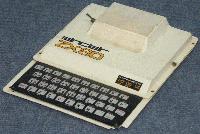 The Sinclair ZX80 . This machine shipped with integer basic and 1K of RAM.
This one has been upgraded to floating point BASIC with a new keyboard overlay.
Here are views of the back, and
inside (with original keyboard visible).
The Sinclair ZX80 . This machine shipped with integer basic and 1K of RAM.
This one has been upgraded to floating point BASIC with a new keyboard overlay.
Here are views of the back, and
inside (with original keyboard visible).
This machine is in fairly poor shape - I would like to find a sample in better
condition - if you have one, please contact me.
The Sinclair ZX80 - Byte Jan79 (1M PDF)
ZX81 and Timex 1000
A year after the introduction of the ZX80, Sinclair released an updated
model with floating point basic, a better case, and a new "flicker free" video
mode (which could be turned off because it make the computer run much slower).
A custom IC allowed the chip count to be further reduced to only 5. The ZX81
was sold in North America under the name "Timex 1000".
Sinclair ZX81s were donated by Chris Witkowski, Jim Fare and Jim Horn.
 Complete ZX81 system. Clockwise from upper left:
Complete ZX81 system. Clockwise from upper left:
Box from memory module, ZX81 with RAM module attached on back, Sinclair printer
(with two extra paper rolls behind), ZX81 Basic Programming manual, ZX81
assembly guide, ZX81 Assembler tape, ZX81 cassette interface cable.
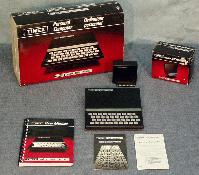 The "American" version of the ZX81 - the Timex 1000.
The "American" version of the ZX81 - the Timex 1000.
Clockwise from upper left: Original Box, Memory expansion module, Memory
expansion module box, T1000 (center), getting started notes, T1000 user
manual.
Back-of-box.
 The front of the ZX81 and the T1000. Note the labels in and over the keys.
These machines were "impossible" to type on, but all BASIC commands and
keywords were entered with a single key, making it much easier to enter
programs in spite of the poor keyboard. Note the socket on the top of the
ZX81, this was a modification by the original owner to connect an external
keyboard. Also note the silver connector on the back, this was another
modification to connect baseband video, because the built in RF modulator
was notoriously bad.
The front of the ZX81 and the T1000. Note the labels in and over the keys.
These machines were "impossible" to type on, but all BASIC commands and
keywords were entered with a single key, making it much easier to enter
programs in spite of the poor keyboard. Note the socket on the top of the
ZX81, this was a modification by the original owner to connect an external
keyboard. Also note the silver connector on the back, this was another
modification to connect baseband video, because the built in RF modulator
was notoriously bad.
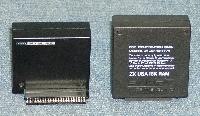 A pair of 16K RAM expansion modules (One T1000, One ZX). These plugged into
the back of the computer with a very shakey connection. When using these
modules, the slightest movement of the computer would often cause it to crash.
For this reason, many expanded ZX81's were outfitted with an external keyboard,
so that you did not have to touch it during operation.
A pair of 16K RAM expansion modules (One T1000, One ZX). These plugged into
the back of the computer with a very shakey connection. When using these
modules, the slightest movement of the computer would often cause it to crash.
For this reason, many expanded ZX81's were outfitted with an external keyboard,
so that you did not have to touch it during operation.
Here is a view other side.
 The Sinclair micro printer. This tiny printer was the perfect companion for
your ZX81. It worked by burning dots into a metalized paper.
The Sinclair micro printer. This tiny printer was the perfect companion for
your ZX81. It worked by burning dots into a metalized paper.
Here is a rear view.
 Documents in my collection for the ZX81.
Documents in my collection for the ZX81.
 ZX81 parts layout and schematic drawing. This is one side of the "Assembly
Manual" which is actually just a folded double sided sheet.
ZX81 parts layout and schematic drawing. This is one side of the "Assembly
Manual" which is actually just a folded double sided sheet.
ZX81 advertisement.
Timex/Sinclair ZX80/81 simulator.
Z80 CPU Technical Manual (5M PDF)
Timex/Sinclair 1500
The ZX81/T1000 was very popular due to the low selling price, however people
did have a few major compaints. The two most problematic aspects were the poor
keyboard, and the small amount of memory (coupled with the fact that the memory
expansion connector was quite unreliable).
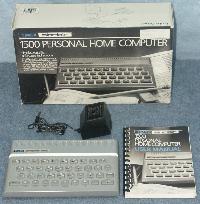 In 1983 Timex/Sinclair announced an updated system called the "1500".
In 1983 Timex/Sinclair announced an updated system called the "1500".
This is essentially a standard ZX81 in a Sinclair Spectrum case, with a
(slightly) better keyboard and 16k of RAM built in. In all other respects
it is identical to the ZX81.
Views:
Close-up,
Back,
Bottom,
Back-of-box.
Donated by Jim Horn.
QL
The "Quantum Leap" was Sinclair's attempt at a professional/business
machine. Plagued by production delays and bugs in the initial design, it
never really caught on, however it was a powerful and cutting edge machine
for it's time, and it still has a loyal following of users.
The Sinclair QL was donated by Graeme Peterson.
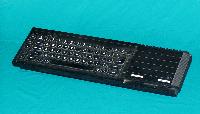 The Sinclair QL console - note the square keys with circular depressions.
At the lower right corner are two "micro drives", very small tape drives,
which were the only official storage medium.
The Sinclair QL console - note the square keys with circular depressions.
At the lower right corner are two "micro drives", very small tape drives,
which were the only official storage medium.
Right side view - contains only a RESET switch.
Left side view - Expansion connector, options could
be "stacked" on this connctor, and there are reports of QLs expanded to 4 feet\
long!
Back panel - Left to right: Network(2), Power Input, RGB video
out, UHF TV out, Serial ports(2), Controller (joystick) ports(2), ROM cartridge
slot.
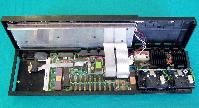 Inside the QL - The expansion slot is on the left, main logic board
is in the middle (here we can see an upgrade which includes a new ROM
and an I2C controller). On the left are the
microdrive tape units.
Inside the QL - The expansion slot is on the left, main logic board
is in the middle (here we can see an upgrade which includes a new ROM
and an I2C controller). On the left are the
microdrive tape units.
 This is a "Trump card" from Miracle Systems - this was a necessary
add-on to the QL, which includes a floppy disk controller, expanded
memory, and a toolkit in ROM.
This is a "Trump card" from Miracle Systems - this was a necessary
add-on to the QL, which includes a floppy disk controller, expanded
memory, and a toolkit in ROM.
 Left: QL power supply, Right: Serial to parallel printer interface, and
two I2C interface modules.
Left: QL power supply, Right: Serial to parallel printer interface, and
two I2C interface modules.
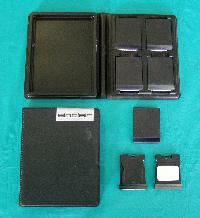 These are the Microdrive tape cartridges. Each cartridge contains a
loop of tape (see inside). Cartridges are
normally stored in a protective sleeve (upper cartridge), and removed
for insertion in the machine (lower two top/bottom).
These are the Microdrive tape cartridges. Each cartridge contains a
loop of tape (see inside). Cartridges are
normally stored in a protective sleeve (upper cartridge), and removed
for insertion in the machine (lower two top/bottom).
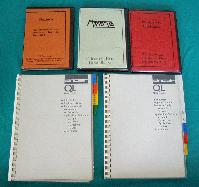 Sinclair QL documentation. I also have a number of
technical documents.
Sinclair QL documentation. I also have a number of
technical documents.
Sinclair QL Frequently Asked Questions (76k TXT)
Sinclair VisionQL monitor owners guide (60k pdf)
Sinclair QL simulator (dos)
Sinclair QL simulator (win)
Back to Old Computers
Copyright 2004-2005 Dave Dunfield.
 The Sinclair ZX80 . This machine shipped with integer basic and 1K of RAM.
This one has been upgraded to floating point BASIC with a new keyboard overlay.
Here are views of the back, and
inside (with original keyboard visible).
The Sinclair ZX80 . This machine shipped with integer basic and 1K of RAM.
This one has been upgraded to floating point BASIC with a new keyboard overlay.
Here are views of the back, and
inside (with original keyboard visible).












